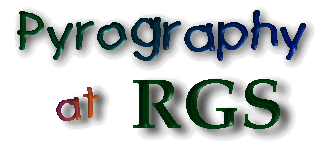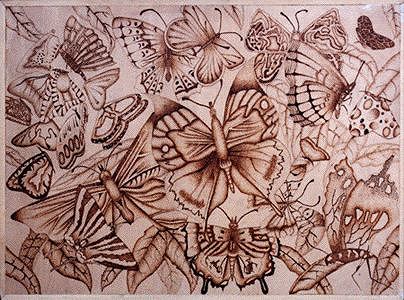Back Issues Carvers' Companion Gateway |
| Backlane by Seet Peh San, 1995 Raffles Girls' School (Secondary) Singapore |
Raffles Girls' School (Secondary)
Raffles Girls' School (Secondary)--or RGS for short--is one of a few schools in Singapore named for Sir Stamford Raffles, who founded Singapore in 1819. Schools in Singapore follow the British school system, and this one, a secondary school, teaches four grades--secondary one through four--that are about the same as grades 7 and 8 of American middle school and grades 9 and 10 (freshman and sophomore year) of American high school. At the end of their secondary school, when they are generally sixteen years old, students at Raffles complete exams called Cambridge GCE 'O' Level exams in order to graduate. Their next school would be what in Singapore is termed a junior college (the approximate equivalent of American junior and senior years in high school) where they would need to pass the Cambridge GCE 'A' level exam to graduate and go on to the university.

Christine Tan is one of three art teachers at Raffles Girls' School (Secondary), but she is the only one of the three who teaches pyrography. The students at Raffles range in age from 12 to 16. In secondary one and two at Raffles, when the girls are 12 to 14 years old, art is a compulsory subject; however, pyrography is not part of the standard curriculum. After that, art is optional, and Christine says that at RGS very few girls opt for art, which, like other electives, is conducted outside curriculum time from 2:30-6:30 p.m. once a week. Christine, who herself took a short course in pyrography some years ago from a teacher in another school, introduces pyrography only to these older students in secondary three and four who have chosen art as an elective. Notwithstanding, this optional course work forms part of the final GCE 'O' Level Art Exam.
All the work displayed here is done by 16-year-old girls, who chose pyrography as one of the media to complete their coursework for art as part of their 'O' level work.
| Sunflowers by Tay Jo Li, 1996 Raffles Girls' School (Secondary) Singapore |
Technique and Tool
Christine believes that the success of a pyrograph depends largely on technical control of the tool when burning the wood and on the ability of the artist to draw well, that is, to "have an understanding of and sensitivity for form, line, shape, textures, spatial relationship, etc."
Christine's students use a simple electric soldering iron (40-watt) burning tool with a pointed tip. Although there are other more powerful tools with more metal tips available, she prefers the tool used at RGS because it enables the girls to control the burning. Christine acknowledges that this process is time consuming, but holds that they can produce the desired tones and textures with fewer mistakes. The girls find pyrography demanding, but are very gratified when they see their image gradually being revealed.
|
|
| A Street in Hong Kong by Yueng Ka Wah Joan, 1993 Raffles Girls' School (Secondary) Singapore |
Pointillism Method
Christine calls the method she teaches "pointillism in wood." It is done by making countless dots with the pointed tip. In addition, where appropriate, different effects can be obtained by rubbing or sliding the metal tip, or the side of it, over the wood surface.
|
|
| Sungei Road Singapore by Yeo Su Fen, 1995 Raffles Girls' School (Secondary) Singapore |
Pyrography Designs
Christine encourages her students to work on local themes, scenes familiar to them, and on nature and the environment. She does not provide designs for them and instructs them to do their own research and drawings, and to make modifications. "Originality is important," she says, "and wholesale copying is out of the question."
At RGS, they do not add color to their pyrographs. Christine adds, "In fact, I never thought of doing it. I prefer the monochromatic sepia effect." The girls work on standard technical boards, 24 inches by 18 inches in size, which can be readily purchased at art supply stores. They are made of jelutong, a light-colored wood that allows for a wide range of tones when burning the surface. The pyrographs displayed here have so far not been lacquered.
 |
| Butterflies by Heidi Au Yeung, 1994 Raffles Girls' School (Secondary) Singapore |
Singapore Youth Festival
As part of the annual Singapore Youth Festival, there is a national Art and Craft Exhibition, which alternates each year between the secondary and primary schools. From the number of entries in pyrography she has seen there that were obviously generated from the 'O' level exam, Christine deduced that pyrography at secondary four level is quite a popular medium in some schools. Do the Raffles girls continue with their pyrography after 'O' Level? Christine notes that the girls have a very busy program and no time to do special pyrography projects once they've completed their art course.
| Singapore by Sim Yueh Ting, 1992 Raffles Girls' School (Secondary) Singapore |
Our deepfelt gratitude to the Raffles Girls' School, to Chua Guat Kheng for coordinating this project and providing us these images, and to Christine Tan for telling us about your art program and especially your work with the girls in pyrography. Very special thanks to Christine's fourth-level art students for sharing your extraordinary pyrographic art work with us. We hope once you see your work in this article and in the E-Museum and realize how wonderful it is and how much it means to all of us, you will continue to use your remarkable talents to explore this beautiful, intriguing medium.
 |
Back
to Part I of Pyrography and Kids: Jarea Art Studio, Canada--folk art poker work by Jantje Mulder, and her work and her daughter Andrea's teaching pyrography to children. |
©1998 Kathleen M. Garvey Menendez
